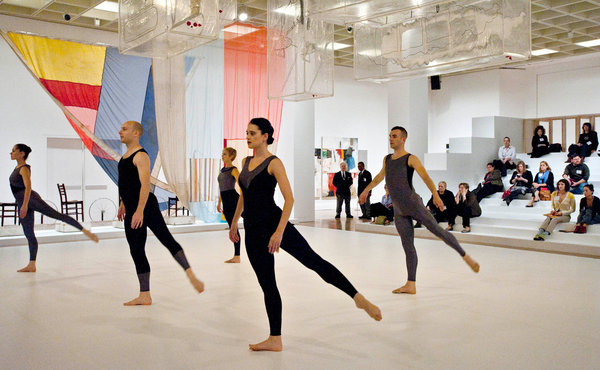
Philippe Parreno: Dancing around the Bride’s sixth artist
By: Norman Keyes and Jaime Bramble Schell, Philadelphia Museum of Art
The Philadelphia Museum of Art’s Dancing around the Bride exhibition, generously supported by the John S. and James L. Knight Foundation, is focused on the interwoven lives, works, and experimental spirit of Marcel Duchamp and four of the most important post-war artists of our time: John Cage, Merce Cunningham, Robert Rauschenberg, and Jasper Johns. Starting with an extensive period of conversations and engagement in the 1950s and ’60s, these artists together developed new models of artistic collaboration and chance-based work, creating pieces that traverse the distinctions between visual art, music, and dance that continue to inspire and define contemporary arts today. Yet, there is another artist whose work is integral to the exhibition—Paris-based Philippe Parreno. Serving as the metteur en scène, or orchestrator, to Dancing around the Bride, he brings the perspective of another generation to the work of the five artists. Parreno recently stopped by the Philadelphia Museum of Art (PMA), and we had the chance to sit down with him to ask a few questions…
Constance Mensh/Philadelphia Museum of Art
PMA: In this exhibition there are five featured artists. Yet, your work is so critical to bringing a historic moment into the present that you become a sixth artist featured alongside these post-war figures. What does that mean for you as a responsibility to the major talents in the show? Parreno: The responsibility is huge, so as stage director I’m trying to convey the sense of changing ideas, motifs, and forms with respect to the fantastic collectivity, or community rather, of these artists. I also want to convey the feeling that visitors can be part of the dynamic, too—the sense that they are almost dancing with the artists and the other works in the show. That momentum makes it all feel very alive. The work of Cage and Duchamp and the others still haunts us and these artists still have things to teach us.
PMA: Can you describe some of the elements that make up your interventions in the exhibition? Sound is key, is that right? Parreno: Yes, sound is very important. We have two pianos that are programmed to play pre-recorded performances of John Cage compositions, yet in another area sound is suppressed, providing a sense of intimacy and isolation as you move from one space to the next. The sound outside the Museum is just as important as the music that circulates inside the exhibition walls. We pay homage to John Cage by incorporating these ideas. We also recorded the sounds of the dancers’ footsteps. The dance floor plays their footsteps like a speaker, enabling the ghosts of the dancers to move across the floor even when they’re no longer there.
PMA: How did you and Carlos Basualdo and Erica Battle, the PMA’s curators of Dancing around the Bride, first begin talking about how you could collaborate on this exhibition? Parreno: The conversations began a few years ago. Carlos and Erica contacted me after experiencing my exhibition at the Serpentine Gallery in London in 2010. Carlos told me about the idea for the show, and there were no real rules to follow, so we just let the process flow. Ideas came and went and we had many discussions before any decisions were made, then we went about filling in the gaps. This was doubly exciting for me as I had never worked with Carlos and Erica before.
PMA: One of the things you’re interested in is how one moment in time can be mediated in another. This show looks mostly at the 1950s and ’60s through a contemporary lens, so it’s a natural opportunity for you in many ways, isn’t it? Parreno: Yes, I’ve always believed that the exhibition itself is its own art form. It too is an object of art, and you must think almost in cinematic or musical terms to link one image with another within the exhibition space. The question becomes: how do you embrace the space, how can one thing lead you to think about something else differently?
PMA: Is there a social dimension to this that interests you? Relationships among the artists, between the audience and the artists, between the audience and the objects? Parreno: Of course, and in a show like this, these things often blur. The lines between events and representations cannot be easily defined, therefore the mise-en-scéne is almost like a phantasmagoric séance; the contours are ghostly.
PMA: What do these artists mean to you? Parreno: All of them were extremely important to me and my understanding of art in many ways. Also, today, it’s important to bring back these dances and compositions from art history and make them new again. To dance with them again in a new setting.
PMA: What can artists today take away from these artists? Parreno: The feeling of community and the notion of reinventing the nature of an object through relationships set up by games and play. These artists were players, and the nature of play is the nature of any revolution. We must never stop playing.
Recent Content
-
Artsarticle ·
-
Artsarticle ·
-
Artsarticle ·

